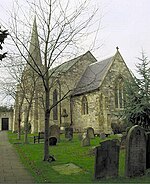York Community Woodland
Forests and woodlands of North YorkshireOutdoor recreationUse British English from September 2024York

York Community Woodland is a Forestry Commission site near to Knapton in York, England. The site covers 78 hectares (193 acres), and by its opening in 2024, 210,000 trees had been planted. The site is owned by the City of York Council, and offers an open space on the western side of the City of York. Spare land has been allocated on the eastern side for a possible ring road expansion, and when the landfill site to the west is remediated, provision has been made for the woodland to expand over that area.
Excerpt from the Wikipedia article York Community Woodland (License: CC BY-SA 3.0, Authors, Images).York Community Woodland
Moor Lane, York Rufforth with Knapton
Geographical coordinates (GPS) Address Nearby Places Show on map
Geographical coordinates (GPS)
| Latitude | Longitude |
|---|---|
| N 53.96 ° | E -1.16 ° |
Address
Moor Lane
Moor Lane
YO26 6QN York, Rufforth with Knapton
England, United Kingdom
Open on Google Maps









